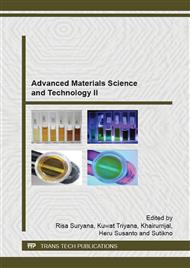[1]
J. de Vicente, D. J. Klingenberg, and R. Hidalgo-Alvarez, Magnetorheological fluids: a review, Soft Matter, vol. 7, no. 8, p.3701, (2011).
DOI: 10.1039/c0sm01221a
Google Scholar
[2]
S. Yokota, K. Yoshida, and Y. Kondoh, A pressure control valve using MR fluid, Proc. JFPS Int. Symp. Fluid Power, vol. 1999, no. 4, p.377–380, (1999).
DOI: 10.5739/isfp.1999.377
Google Scholar
[3]
X. Wang, F. Gordaninejad, G. H. Hitchcock, K. Bangrakulur, A. Fuchs, J. Elkins, C. a. Evrensel, U. Dogruer, S. Ruan, M. Siino, and M. Q. Kerns, A new modular magneto-rheological fluid valve for large-scale seismic applications, Smart Sturctures Mater., vol. 5386, p.226–237, Jul. (2004).
DOI: 10.1117/12.540275
Google Scholar
[4]
D. H. Wang, H. X. Ai, and W. H. Liao, A magnetorheological valve with both annular and radial fluid flow resistance gaps, Smart Mater. Struct., vol. 18, no. 11, p.115001, Nov. (2009).
DOI: 10.1088/0964-1726/18/11/115001
Google Scholar
[5]
F. Imaduddin, S. A. Mazlan, H. Zamzuri, and I. I. M. Yazid, Design and performance analysis of a compact magnetorheological valve with multiple annular and radial gaps, J. Intell. Mater. Syst. Struct., vol. 0, no. 0, p.1–12, Oct. (2013).
DOI: 10.1177/1045389x13508332
Google Scholar
[6]
F. Imaduddin, S. Amri Mazlan, M. Azizi Abdul Rahman, H. Zamzuri, and B. Ichwan, A high performance magnetorheological valve with a meandering flow path, Smart Mater. Struct., vol. 23, no. 6, p.065017, Jun. (2014).
DOI: 10.1088/0964-1726/23/6/065017
Google Scholar
[7]
J. D. Carlson and M. R. Jolly, MR fluid, foam and elastomer devices, Mechatronics, vol. 10, no. 4–5, p.555–569, Jun. (2000).
DOI: 10.1016/s0957-4158(99)00064-1
Google Scholar
[8]
T. Data, MRF-122EG Magneto-Rheological Fluid, Lord product selector guide: lord magnetorheological fluids, 2008. www. lord. com.
Google Scholar
[9]
T. Data, MRF-132DG Magneto-Rheological Fluid, Lord product selector guide: lord magnetorheological fluids, 2011. www. lord. com.
Google Scholar
[10]
T. Data, MRF-140CG Magneto-Rheological Fluid, Lord product selector guide: lord magnetorheological fluids, 2008. www. lord. com.
Google Scholar
[11]
H. X. Ai, Design and modeling of a magnetorheological valve with both annular and radial flow paths, J. Intell. Mater. Syst. Struct., vol. 17, no. 4, p.327–334, Apr. (2006).
DOI: 10.1177/1045389x06055283
Google Scholar
[12]
D. H. Wang, H. X. Ai, and W. H. Liao, A magnetorheological valve with both annular and radial fluid flow resistance gaps, Smart Mater. Struct., vol. 18, no. 11, p.115001, Nov. (2009).
DOI: 10.1088/0964-1726/18/11/115001
Google Scholar
[13]
A. Grunwald and A. G. Olabi, Design of magneto-rheological (MR) valve, Sensors Actuators A Phys., vol. 148, no. 1, p.211–223, Nov. (2008).
DOI: 10.1016/j.sna.2008.07.028
Google Scholar


